#mola mola are actually great divers!
Explore tagged Tumblr posts
Text
They’re related to pufferfish and they have two large teeth plates that help them mush their food! That’s right, the ocean sunfish has lots of surprises up its sleeve–err, fins?
While it’s a delight to have them in our Open Sea exhibit, these pancake-like fish are not permanent residents of the Aquarium. When we do host them–usually in spring or summer–they stay with us for a few months before being tagged and released back in the wild as our scientists monitor their behavior and well-being.
#monterey bay aquarium#chewing the food before swallowing it isnt really their thing#dont be foooled by their size or shape#mola mola are actually great divers!
2K notes
·
View notes
Text
Welcome back to the series where I talk about evey fish pokemon’s origins and their real-life inspirations, this time covering gens III and IV. See here for gens I and II.
Staring off with Carvanha and Sharpedo. Carvanha is based on a piranha, specifically a red-bellied piranha.

"I'm mot really that scary" (image: a piranha)
When I say “based off of” I mean that in a pretty loose way. It really looks nothing like a piranha and more like an artistic depiction of a generic “scary fish”. Let’s talk about piranha because they are probably the world’s most slandered fish. Piranha are not the hyper-vicious super-predators that roam the Amazon devouring everything in their path that media depicts them as. They’re actually omnivores rather than obligate carnivores and mostly scavenge the dead. The stories of them attacking and skeletonizing large animals in minutes come from times when European explorers would be shown displays where schools of piranha would be trapped and starved for a long time to get them to act like that. Attacks on humans are rare and usually happen when the human gets too close to a piranha’s eggs, prompting a warning bite. If you still aren’t convinced that they aren’t fishy murder machines, check this video of River Monsters’ Jeremy Wade getting into a pool of hungry piranha and not getting bit at all
youtube
(this is not me telling you to go swim with piranha. Always be cautious when around wild animals)
Like piranha, Carvanha is much more dangerous in groups. Real piranha only school part of the year while Carvanha do it permanently. Carvanha is a river fish like piranha, but it also has a lot of shark features that fit its evolution. It can smell blood from far away (a feature of both piranha and sharks) and has the famous placoid scales or denticles of sharks. Evolving Carvanha causes it to go from bony fish to cartilaginous fish in the form of the franchise’s first shark. Sharpedo seems to be a generic shark similar to a great white (it even has countershading) but missing its back half. This is similar to the ocean sunfishes of family Molidae, most famously the Mola mola itself.

(image: scuba divers swimming alongside a mola)
This is funny because sharpedo, an active and very fast ambush hunter, could hardly have a more different lifestyle than the Molas, who are slow and mostly eat jellyfish. Sharpedo is also based on a torpedo, and in later games where it’s ridable it seems to function like a jet ski. Like sharks, Sharpedo has placoid scales that are exaggerated in its mega evolution and faces overfishing from people using its dorsal fin in food. Mega Sharpedo having denticles on the sides of its snout point to inspiration from the sawfish, a shark relative.

Easily one of the fakest-looking real fish (image: a sawfish)
Barboach is a loach while Whiscash is a catfish. Barboach seems to specifically be a pond loach, which buries itself in sediment to avoid danger (hence the ground typing), can sense changes in weather (a big deal in this gen), and are common food fish and aquarium pets. Loaches are long and skinny and have barbels like Barboach.
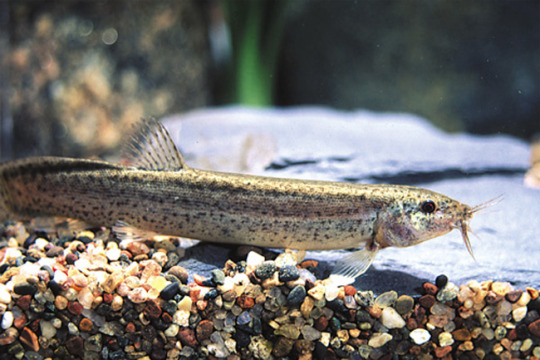
(image: a loach)
Barboach may also draw from the loach catfish, which is a catfish that looks like a loach, tying into its evolution. Wishcash may also be based on the loach catfish, but it look much more like a conventional catfish. Whishcash’s connection to earthquakes (both causing and sensing them) is inspired by a creature from Japanese legend. Namazu is a gigantic catfish living under the islands and guarded by a god who restrains it with a rock. When the god’s guard slips, Namazu thrashes about and causes earthquakes.

(image: a depicition of Namazu)
Both loaches and catfish have barbels that are used for sensing. These barbels help both groups of fish live in very murky water by making them less reliant on sight. Because of this, loaches and catfish can live in water with very poor visibility and lots of sediment in the water column. Barboach and Wishcash can likewise be found in very muddy water and other places of poor visibility, like caves. Them being found in caves in some regions may also reference blind, cave-dwelling catfish.
Feebas is a bass, though it’s more based on the story of the ugly duckling. Just like in the story, you start out with a ugly little creature and turn it into something beautiful. I’m going to be perfectly honest, I don’t really see much bass in Feebas, I think it’s based much more on Magikarp than a bass, who are often pretty powerful predators, something Feebas isn’t. like with Mgikarp, I won’t be discussing Milotic in this as I think it’s a sea serpent rather than a fish.
Ok so there is a good explanation for why a fish evolves into an octopus. I hoped I could find a good explanation for why a clam evolves into eels, but I simply have no explanation for the Clamperl line. Huntail and Gorebyss really have no connection to their pre-evo. I won’t talk about Clamperl since (and this is some high-level biology so I hope you can follow me) clams aren’t fish. Both final form are based on deep-sea eels and eel-like fish. Huntail seems to have some basis with the gulper eel as both are sit-and-wait predators with very large mouths, though Huntail is a more active predator as it does have some powerful teeth.
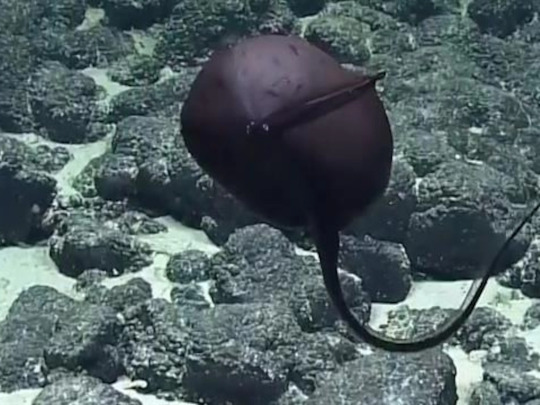
Turns out gulper eels are a lot goofier than you'd think (image: a gulper eel with its mouth inflated)
These teeth may draw influence from other deep-sea predators with massive chompers, like viperfish or the fangtooth. Its use of its tail as a lure is a reference to the various deep-sea fish that use bioluminescent lures to attract prey. This is an example of caudal mimicry, where an animal’s tail mimics something else to lure in prey. A cool example of this is the spider-tailed horned viper, which you should look up if you don’t like bugs, I promise it’s definitely not really creepy. Finally, Huntail’s general longness, color pattern, and crest are references to the oarfish, one of my favorites. This deep-sea longboi is a rare sight at the surface but is believed to be responsible for stories of sea serpents because of how huge they can get.

Long, long man! (image: an oarfish)
Gorebyss similarly has a complex origin for a very forgettable Pokémon. It seems to primarily be based on snipe eels, which are deep-sea eels with long, slender jaws.

(image: a snipe eel)
Gorebyss’s jaws are fused into a needle, which is similar to pipefish, a relative of seahorses with a very similar fused snout. Some inspiration could also come from the deep sea-dwelling long-nosed chimeras, some species of which have a long, conical snout very reminiscent of gorebyss’s head shape.
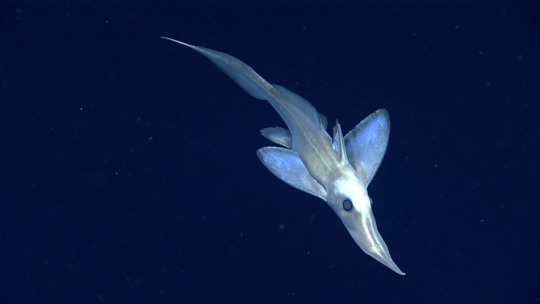
(image: a long-nosed chimera)
Unlike most of its influences, Gorebyss is an active predator and its habit of stabbing its prey with its snout and injecting digestive juices to slurp its prey dry seems to be in reference to spiders and mosquitos.
Hot damn, Hoenn has a lot of fish. The next up is Relicanth, which is a pretty straight-forward reference to the coelacanth.

(image: a rare picture of a wild coelacanth)
Both are very ancient fish thought to have gone extinct until they were rediscovered in modern times. This makes them examples of what scientists call a Lazarus taxon. Ceolacanths are pretty cool fish. Along with lungfish, they are the only surviving lobe-fined fish. These fish were separated from the more common ray-finned fish by having their fins seated on fleshy lobes extending from the body, usually with bones in them (lungfish have lost the bones). Also when I say that coelacanths and lungfish are the only surviving lobe-finned fish, that’s not exactly true. It’s a principle in taxonomy (the study of how groups of life are related) that you can’t evolve out of your ancestry. You belong to every group your ancestors belonged to, even if you started a new group they aren’t part of. Tetrapoda is the clade of four-legged vertebrates skeletally adapted for life on land and they evolved from lobe-finned fish. That means every mammal, reptile, amphibian, bird, and so on, including yourself, is a lobe-finned fish. Coelacanths are most famous for being rediscovered alive and seemingly unchanged when they were thought to have gone extinct millions of years ago. They are often called living fossils for how little they appear to have changed. This term is pretty misleading and many biologists don’t like using it. In fact the coelacanths of today are different than those that swam with plesiosaurs, pretty radically in some cases. Coelacanths are often used in arguments by cryptozoology enthusiasts for why their favorite dinosaur/plesiosaur/megalodon/whatever could still be alive and unchanged today despite leaving no fossil record. However a fish remaining relatively similar to its ancestors due to living in a very stable environment that doesn’t have the selective pressures encouraging radical change is very different than an apex predator or massive reptile doing so in an environment that has undergone massive changes and multiple major extinctions. I’ll link a video for more on why the coelacanth is a red herring in these kinds of arguments.
youtube
Finally finishing out Hoenn we have Luvdisc, possibly the most unnecessary Pokémon ever. Someone please give this poor fish an evolution so it can finally have a purpose. Paldea gave us updates to Delibird and Dunsparce so it’s definitely possible for Luvdisc to get some love. Anyway, it’s a discus fish. These are thin-bodies cichlids whose dorsal and anal fins make them kind of look like hearts, though Luvdisc is missing the tail fin.
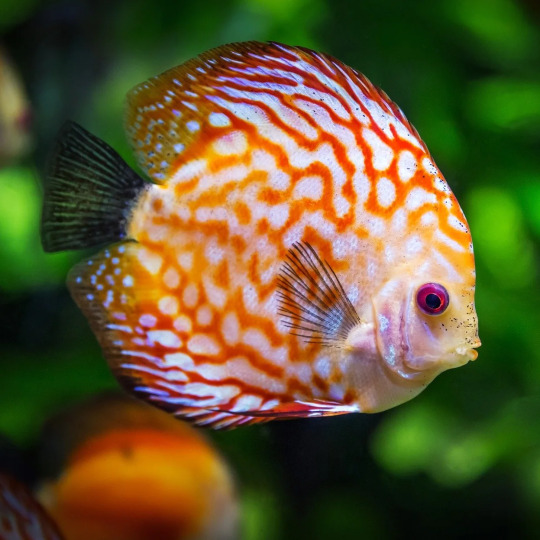
(image: a discus fish)
Like the discus fish, Luvdisc is a social species. Luvdisc's kissing behavior draws primarily from the kissing gourami. These fish engage in behavior where they press their mouths against each other. Scientists believe that this is a form of ritualized aggression, but people think it looks like they’re kissing so these fights have become a symbol of romance.
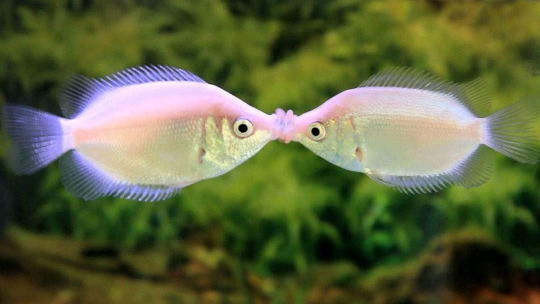
(image: two gouramis "kissing")
They aren’t the only fish that mouth fight. Another species that does this is the sarcastic fringehead, who looks considerably less romantic.
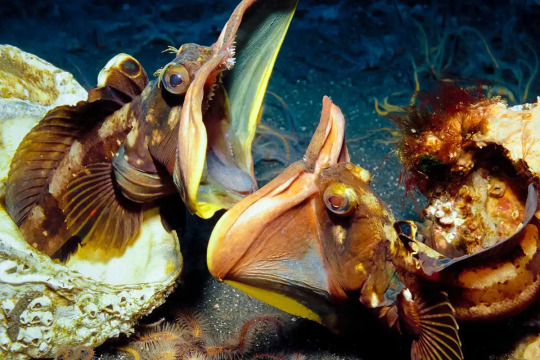
(image: two male sarcastic fringeheads fighting)
After the piscine flood in Hoenn, Sinnoh comes along and introduces a grant total of one fish line, though I will give an honorable mention to the Gible line for being shark plane dragons. Finneon and Lumineon are based on a variety of pretty fish often seen in aquariums, though their fish resemblance to butterflies indicates they are based on the butterflyfish. They have a much closer appearance to the freshwater butterflyfish than the more popular and unrelated saltwater butterflyfish. Both the freshwater butterflyfish and the Finneon line can glide above the water if they build up enough speed. The line’s bright colors may be a reference to brightly-colored tropical fish or aquarium fish like neon tetras. Lumineon actually bioluminesces to attract prey, but risks attracting predators at the same time, a behavior seen in many deep sea fish. it is said to dwell on the sea floor and walk on what I assume are its pelvic fins, which may be a reference to the deep-sea tripod fish.
That's it fro generations III and IV. Next time I'll cover generations V and VI. Hopefully it won't take me nearly as long to get that up.
86 notes
·
View notes
Text
Travel Guide to Candidasa, Bali
You’ve probably heard of the popular Island of the Gods in Indonesia. Bali is a hotspot for backpackers, holidaymakers, yogis, surfers, scuba divers and everyone in between. There are so many things to do and places to visit and there really is something for everyone here.
During our previous trips to Bali, we spent time in Canggu, Sanur, Lovina, Seminyak, Ubud, Kintamani, and more, but this time around, we found ourselves on the east coast in the seaside town of Candidasa — a place that spans less than a kilometer long.
We based ourselves at Lotus Bungalows which is overlooking the water and used it as our base to explore in and around Candidasa. Read on to see if this quieter part of Bali is the place for you,
Don’t miss our travel video of Candidasa at the bottom of this post!
Why Candidasa?
First of all, it’s pronounced “Chandidasa”!
If you’re looking to escape the busy southern beaches, make your way further northeast to Candidasa where you’ll find rice paddies surrounded by palm trees, and Mount Agung looming in the distance. Intricate Hindu temples, friendly locals, relaxed beaches and epic dive sites are all nearby.
The east coast is a great place to base yourself if you’re interested in culture, natural beauty, and scuba diving. For hikers, Mount Agung is still active these days, but when she’s calmed down, trekking the volcano will resume. With many things to see and do in Candidasa, you’ll never be bored here.
This is a slower-paced, less-developed Bali, and while there’s still a lot of traffic, it’s far less hectic than in the south.
These sweet girls stopped us on the street and wanted a photo
Where to Stay in Candidasa, Bali
Candidasa has a road running directly through the town. In order to avoid the traffic noise, I recommend choosing a seaside accommodation and enjoy the sound of crashing waves (and an amazing view).
After a very long travel day from Raja Ampat, we arrived late and were greeted by the friendly property managers at Lotus Bungalows. Sensing how tired we were, Henriette gave us a very brief overview of the property and town of Candidasa.
With the moon illuminating the way and tree frogs, crickets and geckos as the accompanying sound, we made our way through the property and arrived at our bungalow.
Completely exhausted, we pushed our luggage aside and plopped down on the bed — after a much-needed shower in the outdoor bathroom. We were looking forward to seeing what the property looked like in the light of day.
our bungalow at Lotus Bungalows! The property is stunning
As with our previous trip to Gangga Island (North Sulawesi) and Birie Island (Raja Ampat), we were invited by Lotus Hotels to experience Lotus Bungalows here in Candidasa. Having not really seen the property the previous night, we were pleasantly surprised when we woke up and saw the view!
Twenty bungalows dotted the garden, with ours pointing directly to the infinity pool and the Lombok Strait beyond. The architecture was in traditional Balinese style, with an outdoor bathroom, tiled roof and private verandah. Surrounded by towering palm trees and frangipanis, this would be our tropical home for 3 nights.
The room itself had tile flooring, a comfy bed, air-conditioning and lots of natural lighting. As a bonus, we were given a reusable shopping bag for the duration of our stay — helping to reduce the use of single-use plastics in Bali.
On our verandah, we had a clothing rack to dry our swimsuits and towels, plus two chairs and a table. Just steps away was the stunning open-air restaurant — an incredible bamboo structure with mosaic tiles flooring and tasteful wooden decor throughout.
Breakfast was included in the (very affordable) room rate, and we could choose between a la carte, or buffet.
If we wanted, other restaurants were just minutes down the road, but with a perfect view of the sunset, a wood-fired pizza oven, and tasty Indonesian dishes, we ended up eating our meals here at the property.
We both loved the outdoor bathroom!
Apart from the friendly staff members, the onsite dive center, and our cozy bungalow, the large pool was a highlight of Lotus Bungalows. As in most parts of Bali, the sea can be rough depending on the time of year. There are cement barriers along the coast to break up the waves before they reach the shoreline (to help prevent erosion), but waves can still be strong.
Thankfully, we were able to enjoy swimming in the infinity pool while gazing out at the sea. Sunbeds were set up on the grassy area, while chairs and tables for dining and comfy day beds were placed around the pool. It was the perfect place for me to relax while Nick was out scuba diving.
As Candidassa is still quite busy, wherever you choose to stay you should try to find a place that has a respite from the traffic.
To learn more about Lotus Bungalows and the accommodation they offer, click here.
Chillin’ poolside
Scuba Diving East Coast Bali
There are numerous dive sites on the east coast of Bali, many of which aren’t all that far offshore. The 4 Gilis are popular for shark sightings, Amed (a town about an hour from Candidasa) is known for its macro and muck dives, while Nusa Penida and Nusa Lembongan are the places to spot manta rays.
Prior to our visit to Candidasa, we didn’t realize that Bali had awesome scuba diving sites. Of course, Indonesia is known for its underwater world, but we had always thought of Bali as more of a surfing destination.
Wow, were we wrong!
Nick chatted with Hans, the manager at the onsite Gangga Divers shop and after an inspiring and exciting discussion about the creatures they could potentially spot, he checked out the gear and had it put aside for the dives the following morning.
With water temperatures around 17-22 °C in early October, rather than dive in his usual shorts and t-shirt, Nick had to wear a wetsuit this time around.
After about a 20 minute drive, the crew, Nick and the two other divers from Switzerland and Austria arrived at the Padanbai Port. The dive sites were Sental and SD, both of which were around Nusa Penida, and as soon as Nick entered the water, he couldn’t believe he had never been diving in Bali in the past!
Because of its currents, this area is known for manta rays, mola mola (sunfish), reef sharks and turtles, which come to feed on the plankton that is brought to the area with the tides and fast-moving water.
While no mantas or mola mola made an appearance during Nick’s dives, he did see turtles, eels, bump head parrotfish, and lots of healthy coral. After a fun day under the water, he returned with a smile on his face and together with new dive friends, we all enjoyed Bintang beers poolside at Lotus Bungalows.
The pool at Lotus Bungalows was an amazing spot to spend the afternoon!
As with our previous experiences with Gangga Divers on Gangga Island and in Raja Ampat, the 5 star PADI company were professional, and safety was a high priority. Again, Nick had a divemaster to himself while underwater and there are never more than 4 divers for every divemaster.
The dive shop is run by a couple from Denmark, while the divemasters and boat captain are Indonesian. We always like to see locals being employed when possible and Nick had a great experience diving here in Candidasa.
Things To Do In and Around Candidasa
Although the east coast is a great base for scuba divers, there are numerous other things to do here to keep you busy.
Lotus Lagoon
About a 20-minute walk from Lotus Bungalows, you’ll find the Lotus Lagoon, which is filled with (you guessed it), lotus flowers.
This 1000 square meter pond stretches from the road all the way to the sand and is best visited during the morning when the lotus flowers are open (they close during the heat of the day). Another great time is during sunset.
View of the Lotus Lagoon
Pura Candidasa
Directly across the road from the Lotus Lagoon, you’ll find this Hindu temple. When wanting to be blessed with fertility and children, this is where Balinese will come to pray to the Goddess Hariti.
We, however, were there to enjoy the beauty of the temple and hike up the numerous steps to enjoy a view of the Lotus Lagoon, and the sea beyond.
As is customary in all Balinese temples, you must wrap a sarong around your waist (over top of your pants or shorts). Both men and women need to do this. If you don’t have your own, you can usually rent them from stands just outside the temple.
Pura Candidasa temple
Temple Hopping
There are many temples in this area. Just a 30 minute to 1-hour drive from Candidasa will bring you to some magical spots. It’s a good idea to visit a few in one day — either by motorbike/car or with a hired driver.
The Pura Luhur Lempuyang is probably the most famous at the moment — Instagram famous. People line up to get a photo between the two gates of the temple, with a view of Mount Agung in the distance.
Although not as Insta-famous, Pura Luhur Besakih is the holiest and most important temple in Bali. Located on the slopes of Mount Agung, this isn’t actually just one temple, but rather a complex of numerous temples. Ceremonies take place here and it’s a popular spot with tour buses.
About a 30-minute drive from Candidasa will bring you to Taman Tirta Gangga. This 1.2 hectare, aptly named water temple is a sight you don’t want to miss. Here you’ll find fountains, springs, and ponds filled with koi fish, all of which are surrounded by lovely gardens.
The Village of Tenganan
After just a 10 minute drive from Lotus Bungalows, we arrived at this 11th century Bali Aga village (meaning, it’s pre-Hindu). Here, residents live as they have for many years (with the addition of smartphones and TV!). After paying a donation, we were allowed into the village and were showed around by our guide and resident, Wayan.
Walking around with Wayan, we learned about how the villagers here are farmers, have a unique style of weaving (double Ikat) and the men make unique palm calendars. If you visit during the Pandan War, you’ll see traditional combat between the men of the village — using pandan leaves, which have sharp spikes.
This bloody battle is to honour the God of war and is held every June. The Pandan War is a huge event with many people coming from all over Bali to witness it.
Once we were finished with our “tour”, we wandered around aimlessly and saw offerings being delivered for a wedding, children running around, numerous homes climbing up the hillside (with small lanes for exploration), and were offered palm wine by a group of men who were sitting around.
Sure, this is a tourist spot, but it was interesting to see this type of traditional village life.
Note: there’s actually a walk you can do from Lotus Bungalows through the rice paddies to reach Tenganan. If you’d prefer to walk, ask the staff for directions and a guide.
Learning about Tenganan with Wayan
Beach Bumming
While the east coast may not be known for its beaches, there are actually a few beautiful stretches of sand worth checking out. Enjoy a relaxing day at the beach, minus the crowds.
Note: as with all beaches in Bali, be mindful of currents and strong tides. It’s best to ask a local’s advice before swimming.
Pasir Putinh is a gorgeous white sand beach with clear blue water. It’s about a 15-minute ride north from Candidasa. There are sunbeds for rent and a couple of small vendors selling food. Don’t expect an empty beach, but it’s still a beautiful spot, and will be quieter than any beach in the south.
Blue Lagoon near the Padangbai Port is another good option. The beach here is rocky, so it’s a good place to do some snorkelling. Bring your water shoes, or fins.
To the south of Padangbai Port, you’ll find Bias Tugel which is quieter than the Blue Lagoon. Here you’ll find some small vendors, a sandy beach and little rocky pools that you can sit in. It’s also a great spot to watch ships coming and going.
How to Get to Candidasa
Getting to Candidasa is easy. There are numerous international flights that arrive in Bali at the Ngurah Rai International Airport in Denpasar. If you’re coming from Asia or Australia, have a look at Air Asia. If you’re coming from North America or Europe, there are many different airlines and flight options.
We personally flew from New York to Bali via a 5-hour layover in Taiwan. Have a look at your preferred booking engine to compare flights and routes.
Once you’re in Bali, it’s about a 1.5-hour drive from the airport to Candidasa. The traffic in Bali can be horrendous in the south, so the duration of the trip to the east coast can vary. Rush hour runs from around 8-10am and 3-6pm. However, it’s pretty busy throughout the day as well!
If you’re staying at Lotus Bungalows, they will send a driver in an air-conditioned vehicle to pick you up at the airport (for a fee).
Taking a taxi is another option. Fixed rates are posted at the airport, so make sure you go to the official counter and receive your piece of paper with the rate, and the taxi driver number. At the time of our visit in 2019, it was 425,000 IDR. Click here to learn more about taking a taxi from the airport to Candidasa.
If you’d rather utilize rideshare to Candidasa, you’ll need to download either Grab or GoJek on your phone with an Indonesian number. At the airport, after you’ve picked up your baggage and are about to exit, there are a couple of booths selling SIM cards. You’ll need a valid phone number to receive a text and verify your account on these apps.
It’s 260,000 – 350,000 IDR for Grab Car, and GoJek Car is 240,000 – 270,000 IDR. Uber doesn’t operate in Indonesia.
Final Thoughts
Having seen so many other areas of Indonesia, we really enjoyed visiting the east coast. Rather than malls, shops and a lack of nature, this area was relatively undeveloped — there were still some rice paddies on the side of the road!
These rice paddies with Mount Agung in the distance are just on the side of the road in Candidasa
Not only did we enjoy seeing Mount Agung each day and the surrounding palm trees, but this was such a great base for scuba diving. Within a few minutes, Nick was at the harbour and heading out on a dive. Since all the dive sites are located on the east coast, Candidasa is the perfect base.
As a non-diver, I loved staying back at Lotus Bungalows and relaxing poolside, and on the non-diving days, we both enjoyed village visits and temple hopping. As with all trips, there are many things we weren’t able to see during our stay in Candidasa and we’re looking forward to returning.
youtube
A special thank-you to Lotus Hotels for hosting our stay at Lotus Bungalows. As with all promotional campaigns on Goats On The Road, all thoughts and opinions remain our own, regardless of any complimentary services received.
The post Travel Guide to Candidasa, Bali appeared first on Goats On The Road.
Travel Guide to Candidasa, Bali published first on https://travelaspire.weebly.com/
0 notes
Text
6 Best Diving Sites in the World for Beginners and Pros Alike

Giordano Cipriani/Getty Images The ocean covers more than 70 percent of the Earth’s surface, meaning we’ve got some exploring to do. The only passport you need to access this final frontier is a diving certification. The Manual checked in with PADI, the Professional Association of Diving Instructors, which has prepared more than 25 million people over the past 50 years to explore some of the most jaw-dropping diving sites in the world. PADI attests to having the safest and most comprehensive diving curriculum on the planet, so you can feel at ease heading to even the most advanced destinations. PADI experts also gave us an insider’s list of the best diving sites around the world, including massive wall drops, sunken ships, and bizarre creatures. Suit up and dive in!
Great Barrier Reef
Australia The world’s largest living structure, the Great Barrier Reef of Queensland, Australia, is its own planet of uncharted underwater land. I mean, just look at the aerial photos. This spot is huge. “There are countless dive sites to explore on the Reef, most of which require at least an hour travel by boat. Given that the Great Barrier Reef comprises over 3,000 individual reef systems and coral cays, it’s no surprise that no two dive sites are alike,” says an expert team of PADI divers. “Take a liveaboard trip which will take you to the outermost sites. The marine life you’ll encounter is as varied as the sites themselves, with clownfish, reef sharks, turtles, parrotfish, minke, and humpback whales … and not to mention Wally,” a famous hump-nose Maori Wrasse who reached celebrity status on Instagram for his sweet photobombing. Level: All levels (the wreck of the SS Yongala is the most challenging).
Grand Cayman
Cayman Islands Crystal clear waters, stunning offshore wall dives as deep as 6,000 feet, sunken shipwrecks, even sharks — it’s all hidden in the Grand Cayman, which is also a favorite spot for its encounters with stingray and turtles. “Dive operators in the area specialize in personal butler-type diving, allowing divers to make the most of their time underwater,” says Nick Jenny, PADI’s regional manager. Recommended training to make the most out of your dives here includes the PADI Peak Performance Buoyancy and PADI Deep Diver courses to help you hover effortlessly along the walls. Feeling like exploring a wreck instead? Take the PADI Wreck Diver course. Level: Intermediate.
Red Sea
Egypt Egypt may be famous for its pyramids, but the most seasoned divers choose this destination for its gorgeous reefs, wrecks, and marine life diversity. “The region’s wrecks, including the , are often listed among the world’s best,” says head of marketing for PADI Travel, Sandro Lonardi. “The Red Sea is also home to more than 800 species of marine life, of which 10 percent is endemic. Shoals of sharks, including reef sharks, oceanic whitetips, hammerheads, tigers, and threshers, can be seen. Plus, whale sharks, dugongs, and dolphins sometimes surprise lucky divers.” Many of the Red Sea’s diving hotspots are suitable for all levels, adds Lonardi. However, southern dive sites and liveaboard routes are more suited to advanced divers. To make sure you’re ready for diving in the Red Sea, consider enrolling in the PADI Deep Diver, PADI Drift Diver, or PADI Advanced Open Water Diver courses. Level: All levels.
Darwin Island
Galapagos Islands A naturalist’s dream, Darwin Island is located 600 miles off the west coast of Ecuador. The famous archipelago was an integral part of Darwin’s Theory of Evolution, which becomes evident the moment you dive underwater. See marine iguanas, Galapagos penguins, and Galapagos sharks within a unique biodiversity that also houses hammerheads, whale sharks, manta rays, and mola mola (just Google it).

PADI AmbassaDiver Roberto Ochoa Juan Sharks/Galapagos Evolution “When you dive into the Galapagos, you practically dive into a natural history textbook,” says Lonardi. “Keep in mind, underwater conditions in the Galapagos can be rough, and the current is often on the strong side. Some experience with current is a prerequisite for diving here. Many operators require divers to have 50 or more logged dives.” Due to challenging dive conditions, it’s advisable to be at least a PADI Advanced Open Water Diver. Taking the PADI Drift Diver course is highly recommended, while the PADI Digital Underwater Photographer course will allow you to capture amazing photos. Level: Intermediate to advanced.
Silfra Fissure
Iceland Silfra is located directly on the Mid-Atlantic Ridge, a truly remarkable site given it is a massive crack in the Earth caused by the steady separation of the Eurasian and North American tectonic plates. “There’s nowhere else in the world where divers can dive between two continents and place one hand on each tectonic plate,” says the expert divers at PADI. Silfra also boasts crystal clear, filtered glacier water from Langjökull glacier, which fills the crack. “It’s actually the best drinking water you can find – feel free to take a sip on your dive!” says PADI. “But keep in mind, Silfra is 2-4 degrees Celcius year-round, so it is pretty cold! It’s very important to dress well to be prepared for the temperature both in and out of the water.”

Franco Banfi/Getty Images Thingvellir National Park requires all divers to be certified (PADI Open Water Diver or equivalent). The park also requires all divers to have completed a dry suit specialty certification. If a diver does not have this certification, the national park will accept divers with 10 logged dry suit dives in the past two years to come on tour. These dives need to be confirmed by an instructor’s signature. Level: Intermediate to advanced.
Raja Ampat
Indonesia Raja Ampat is known as a “species factory,” which is not an exaggeration. Located off the Northwest tip of Indonesian Papua, this spot is the very heart of the Coral Triangle and home to more species of fish, marine invertebrates, and coral than anywhere else in the world (to be specific, 1,500 species of reef fish and 550-plus of coral, with more discovered each year). “Keep your eyes peeled, as the corals provide homes to colorful reef fish, octopus, cuttlefish, and pygmy seahorses. Green and Hawksbill Sea Turtles are common sightings, and reef sharks and manta rays cruise past in abundance thanks to a ban of shark and manta fishing that was established in 2010,” says Lonardi. Bonus? Expect visibility of 18-20 meters (and up to 40 meters from January to March). “Ocean currents are largely to thank for Raja Ampat’s incredible dive sites and, depending on the moon phase and tide cycle, sites can vary from being accessible to Advanced Open Water Divers to a challenge for experienced divers or simply un-diveable,” adds Lonardi. Recommended training includes the PADI Advanced Open Water Diver course, PADI Drift Diver Specialty, and PADI Peak Performance Buoyancy Course to protect the delicate marine ecosystem here. Expert tip: October to April are the best months for calm seas and marine life. Level: Advanced. Read the full article
0 notes
Text
One of my favorite animals ♡♡ at my favorite place! Stop by the Monterey Bay Aquarium to see these guys!
They’re related to pufferfish and they have two large teeth plates that help them mush their food! That’s right, the ocean sunfish has lots of surprises up its sleeve–err, fins?
While it’s a delight to have them in our Open Sea exhibit, these pancake-like fish are not permanent residents of the Aquarium. When we do host them–usually in spring or summer–they stay with us for a few months before being tagged and released back in the wild as our scientists monitor their behavior and well-being.
#sunfish#open sea exhibit#cute#monterey bay aquarium#chewing the food before swallowing it isnt really their thing#dont be foooled by their size or shape#mola mola are actually great divers!#mola mola#ocean animals#ocean conservation#ocean blog#monterey bay#home#fav place#must see#travel
2K notes
·
View notes